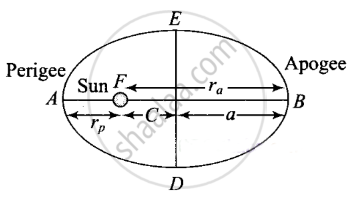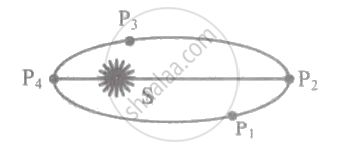Advertisements
Advertisements
Question
A satellite is in an elliptic orbit around the earth with aphelion of 6R and perihelion of 2 R where R= 6400 km is the radius of the earth. Find eccentricity of the orbit. Find the velocity of the satellite at apogee and perigee. What should be done if this satellite has to be transferred to a circular orbit of radius 6R ?
[G = 6.67 × 10–11 SI units and M = 6 × 1024 kg]
Solution
According to the diagram,
rp = radius of perigee = 2R
ra = radius of perigee = 6R
a = semi-major axis of the ellipse
Hence, we can write
`r_a = a(1 + e) = 6R`
`r_p = a(1 - e) = 2R`
`(a(1 + e))/(a(1 - e)) = (6R)/(2R)` = 3

By solving, we get eccentricity `e = 1/2`
If va and vp are the velocities of the satellite (of mass m) at aphelion and perihelion respectively, then by conservation of angular momentum
`L_("at perigee") = L_("at apogee")`
∴ `mv_pr_p = mv_ar_a`
∴ `v_a/v_p = r_p/r_a = 1/3`
Applying conservation of energy,
The energy at perigee = Energy at apogee
`1/2 mv_p^2 - (GMm)/r_p = 1/2 mv_a^2 - (GMm)/r_a`
Where M is the mass of the earth
∴ `v_p^2 (1 - 1/9) = - 2GM (1/r_a - 1/r_p)`
= `2GM(1/r_p - 1/r_a)` .....(By putting `v_a = v_p/3`)
`v_p = [2GM(1/r_p - 1/r_a)]^(1/2)/([1 - (v_a/v_p)^2]^(1/2)`
= `[((2GM)/R (1/2 - 1/6))/((1 - 1/9))]^(1/2)`
= `((2/3)/(8/9) (GM)/R)^(1/2)`
= `sqrt(3/4 (GM)/R)`
= 6.85 km/s
vp = 6.885 km/s, va = 2.28 km/s
For circular orbit of radius r,
vc = orbital velocity = `sqrt((GM)/r)`
For r = 6R, vc = `sqrt((GM)/(6R)` = 3.23 km/s.
APPEARS IN
RELATED QUESTIONS
Answer the following question.
State Kepler’s law of equal areas.
Answer the following question in detail.
State Kepler’s three laws of planetary motion.
If the distance between the sun and the earth is made three times, then attraction between the two will ______
A planet is revolving around the sun in an elliptical orbit as shown in figure. At which point will its K.E. be maximum?

The mass and radius of earth is 'Me' and 'Re' respectively and that of moon is 'Mm' and 'Rm' respectively. The distance between the centre of the earth and that of moon is 'D'. The minimum speed required for a body (mass 'm') to project from a point midway between their centres to escape to infinity is ______.
The earth moves around the sun in an elliptical orbit as shown in the figure. The ratio, `"OA"/"OB"` = x. The ratio of the speed of the earth at Band at A is ______.

If the sun and the planets carried huge amounts of opposite charges ______.
- all three of Kepler’s laws would still be valid.
- only the third law will be valid.
- the second law will not change.
- the first law will still be valid.
Out of aphelion and perihelion, where is the speed of the earth more and why?
A star like the sun has several bodies moving around it at different distances. Consider that all of them are moving in circular orbits. Let r be the distance of the body from the centre of the star and let its linear velocity be v, angular velocity ω, kinetic energy K, gravitational potential energy U, total energy E and angular momentum l. As the radius r of the orbit increases, determine which of the above quantities increase and which ones decrease.
lf the angular momentum of a planet of mass m, moving around the Sun in a circular orbit is L, about the center of the Sun, and its areal velocity is ______.
